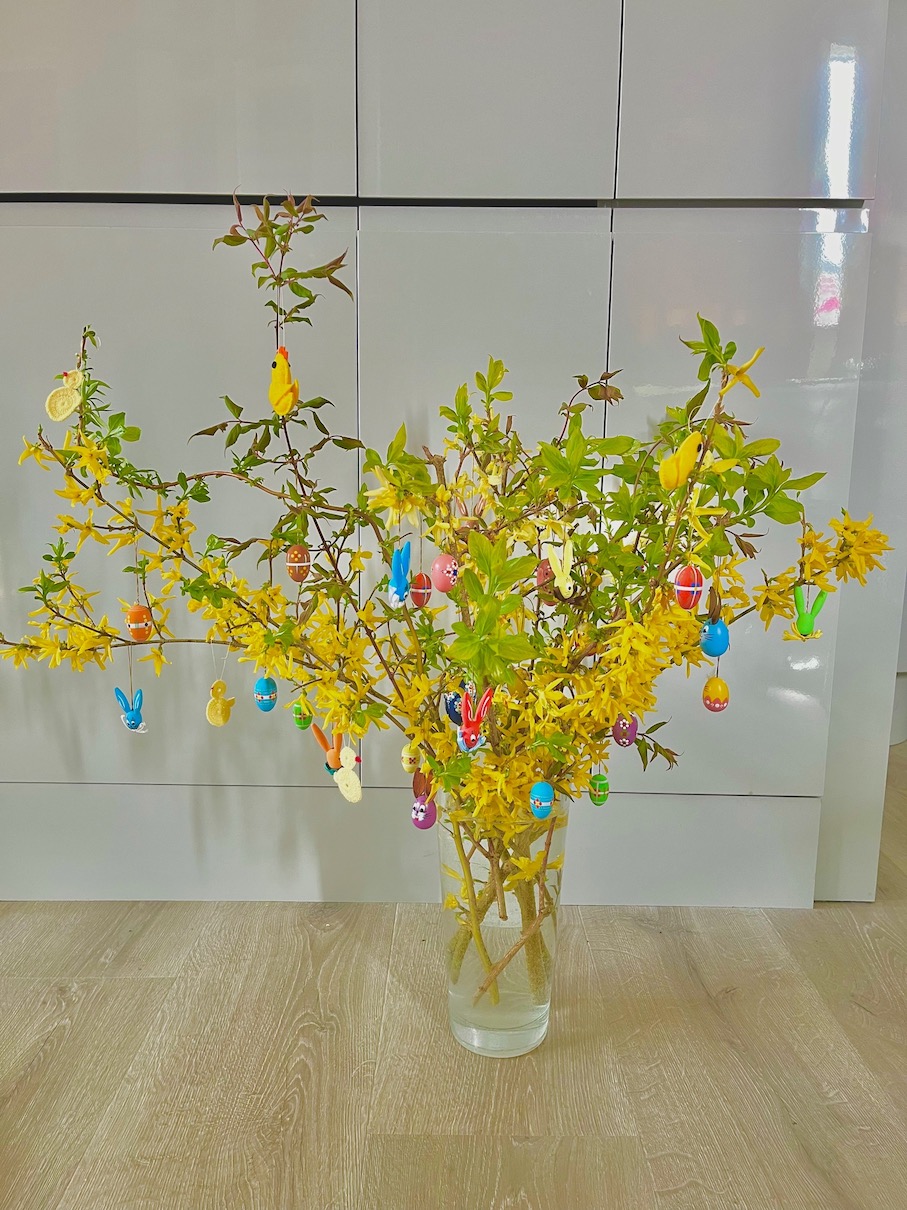
A Guide to fun Easter traditions from around the world
In our house, we blend German and British Easter traditions: I decorate some forsythia branches with beautifully painted wooden Easter eggs (see photo – this is a small-scale version of German Easter egg trees) and decorate the house with various Easter decorations (mostly colourful wooden rabbits of different sizes, some of which are playing in an orchestra). We also do an Easter nest hunt for the kids on Easter Sunday and we decorated eggs when they were younger. We eat hot cross buns, a lamb roast and way too many chocolate eggs (not all at the same time!).
If you’re also from a country where Easter involves a lot of bunnies and colourful eggs (preferably chocolate ones), how about these creative Easter traditions from around the world:
Starting with Greece, where you’ll find Easter eggs, however, they’re all red! That’s because red is the colour of life and represents the blood of Christ. On the Greek island of Corfu, you’ll need to watch out for flying pottery at 11am on Easter Saturday. The tradition dates back to the 16th century and symbolises getting rid of old stuff to make way for new things and scaring away evil spirits with all that noise at the same time.
Speaking of spirits, in Sweden and Finland, children dress up as witches and go around the neighbourhood asking for sweet treats in exchange for Easter cards they’ve made. Witches were once thought to fly to Germany on Maundy Thursday (the Thursday before Easter) to dance with the devil, part of the superstitions around witches in the 16th and 17th centuries. Likewise, the celebrations start the week before Easter.
Probably my favourite take of celebrating Easter is in Norway, where Easter is a long crime novel/TV weekend (I love detective stories too)! Back in 1923, publishers advertised a crime novel with a very real looking news headline and it stuck. People also head to their cabins for some skiing or hiking.
For something quite different, you might like to join people in Bermuda who make traditional kites and fly them on Good Friday. Apparently, a local teacher came up with the idea to explain Jesus’ ascent to heaven.
There are parades in Spain during the whole week (Semana Santa), with the best-known one in Seville, a mini carnival in Brazil on Easter Saturday and what is said to be the biggest Easter celebration in the world in the town of Antigua in Guatemala.
If you’re after even more excitement and actual fireworks, try Florence in Italy where the archbishop fires a rocket into an ancient cart lighting the fireworks on it on Easter Sunday. The ‘explosion of the cart’ dates back 350 years but has its origins in the bravery of a Florentine man during the First Crusade.
A variation of the popular British egg-and-spoon race is the White House lawn egg roll in Washington, USA. This tradition is said to go back to 1878 and involves children rolling hard-boiled eggs with a spoon.
If you’re hungry on Easter Monday after all that chocolate, head to the town of Haux in France where they make the world’s biggest omelette out of 4,500 eggs on Easter Monday. This tradition is said to go back to Napoleonic times when the emperor ordered omelettes to feed his army when passing through the region.
On the other hand, if you fancy something refreshing, you can head to Hungary for a ‘sprinkling’. This involves girls and women being taken to a well and doused with buckets of water for good health and fertility but the buckets of water have now largely been replaced with perfume (much preferable!).
For a proper water fight, head to Poland where the water guns (and buckets!) come out on Easter Monday. This used to be a way for single men to communicate their intentions to their beloved and was believed to bring luck and fertility, but nowadays anyone can participate.
Before you head off, there are two things that are slightly unusual about Easter in 2025: it’s celebrated quite late and the Catholic and Orthodox faiths will celebrate it at the same time. The former is explained by the fact that Easter is set on the first Sunday after the first full moon (as calculated by the Catholic Church) that follows the spring equinox. The latter is because the Orthodox Church follows the Julian calendar, and therefore the date only coincides every 3 to 4 years.
However you celebrate Easter, I hope you have a great time!
PS: Check out my Instagram for some more photos of our decorations!

A fish out of water
You May Also Like

A fish out of water
April 6, 2025
Travelling with apps
June 19, 2025

